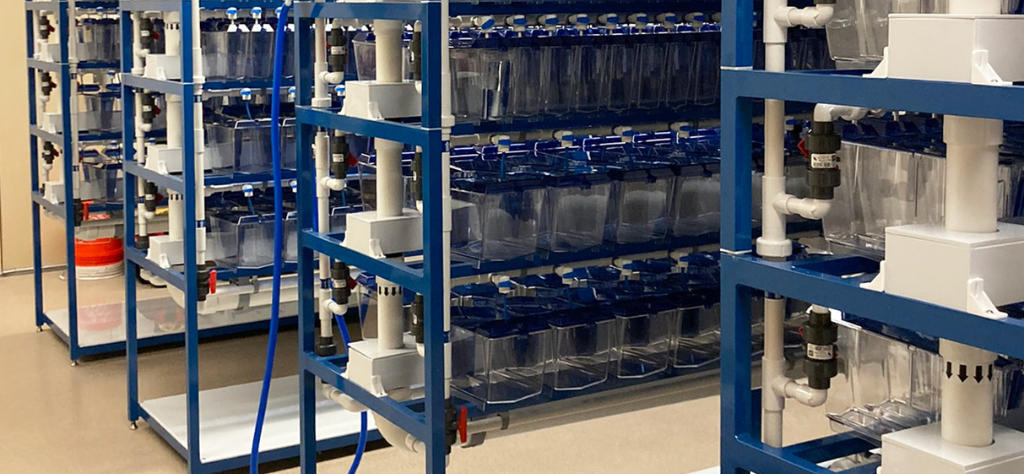Enhancing Zebrafish Care with Automated Aquatic Racks: A Guide to Streamlined Solutions

In the fields of genetics, developmental biology, toxicology, and drug discovery, zebrafish (Danio rerio) have emerged as a cornerstone of biomedical research. They are a perfect model organism for researching a variety of illnesses and biological processes because of their small size, quick reproduction, and genetic resemblance to humans.
However, careful consideration of feeding, environmental factors, and water quality are necessary when keeping zebrafish in a lab environment. Automated aquatic racks can help with this by automating necessary maintenance procedures, guaranteeing ideal conditions, and enhancing research results.
The Importance of Zebrafish Care in Research
Why Zebrafish?
Zebrafish have gained prominence in biomedical research due to their:
- Genetic Similarity to Humans: Zebrafish are a great model for researching human diseases because they share about 70% of the same genes as humans.
- Transparent Embryos: Because their embryos grow externally and maintain their transparency, scientists can track development in real time.
- Quick Reproduction: Zebrafish can produce hundreds of eggs every week, which ensures a consistent supply for research.
- Low Maintenance Costs: Zebrafish require less space and resources to maintain than rodents, making them comparatively less expensive.
Despite these benefits, keeping zebrafish in a research facility has drawbacks, including managing the water quality, feeding the fish consistently, and monitoring the colonies. Automated aquatic rack systems come in very handy in this regard.
What Are Automated Aquatic Racks?
Automated aquatic racks are specialized systems that require little human involvement to house and care for zebrafish. In order to maintain consistent and ideal conditions for zebrafish health and research integrity, these systems use cutting-edge technologies to control important environmental parameters.
Key Features of Automated Aquatic Racks
1. Quality Control and Automatic Water Filtration
- Eliminates hazardous chemicals, waste, and uneaten food.Tracks the levels of oxygen, nitrate, nitrite, ammonia, pH, conductivity, and temperature.
- Maintains steady water conditions, which lowers mortality and stress (cortisol) levels.
2. Automated Feeding Systems
- Delivers food in exact amounts at predetermined times. Prevents water contamination by lowering overfeeding that can happen with multiple users all feeding a varied amount.
- Ensures maximum growth and health of zebrafish populations.
3. Control of Lighting and Photoperiod
- Adjusts circadian rhythms by simulating natural light cycles.
- Encourages healthy cycles of reproduction and development.
4. Monitoring and Data Logging
- Real-time monitoring of environmental parameters.
- Offers anomaly alerts, facilitating quick remedial action.
- Maintains historical data for compliance and consistency in research.
5. Water Exchange Systems That Are Automated
- Minimizes manual labor through effective water replacement.
- Maintains a healthy habitat by preventing the accumulation of harmful substances, mainly toxic nitrite.
Researchers can concentrate on scientific discoveries rather than routine maintenance by automating these important processes.
Benefits of Automated Aquatic Racks in Zebrafish Research
1. Better Health and Welfare of Zebrafish
Keeping the water quality constant is one of the most difficult things about caring for zebrafish. Automated aquaria rack systems guarantee:
- Stable Water Parameters: Reduces stress and disease outbreaks by removing variations in pH, ammonia, nitrite, nitrate, conductivity, and oxygen levels.
- Less Stress in Handling: Zebrafish frequently experience stress from direct human interaction, which automation reduces.
2. Improved Investigation Precision and Replicability
Research can become inconsistent due to variations in lighting, feeding schedules, and water conditions. Using automation:
- Standardized Conditions: Guarantee consistent behavior and growth throughout experiments.
- Accurate Data Collection: Precise documentation for reproducibility is provided by ongoing parameter monitoring and logging.
3. Enhanced Productivity and Financial Savings
Automated aquatic racks have substantial long-term advantages despite their initial cost:
- Reduced Labor Costs: Frequent manual feedings and water changes are no longer necessary thanks to automation.
- Lower Mortality Rates: Research results are more effective and losses are reduced when zebrafish populations are healthier.
- Optimized Resource Usage: Cuts down on needless overfeeding and water waste.
4. Adherence to Regulatory Guidelines
Strict rules regarding animal care must be followed by many research facilities. Automated systems assist with the following:
- Regulatory Compliance: Guarantees that standards established by groups like AAALAC (Association for Assessment and Accreditation of Laboratory Animal Care) are followed.
- Ethical Research Practices: Improves animal welfare, aligning with the 3Rs principle (Replacement, Reduction, Refinement).
Choosing the Right Automated Aquatic Rack System
Selecting the right system depends on several factors:
1. Facility Size and Research Needs
- Small-scale labs may require compact systems with fewer tanks.
- Large facilities benefit from modular systems that allow expansion.
2. Filtration and Water Quality Features
- Look for systems with multi-stage filtration (mechanical, biological, and chemical).
- Ensure real-time monitoring and automated water exchange options.
3. Customization and Flexibility
- Some systems offer adjustable tank configurations to accommodate different research needs.
- Integration with existing lab infrastructure is essential for seamless operation.
4. Ease of Maintenance and Support
- Choose a system with user-friendly interfaces and remote monitoring capabilities.
- Reliable technical support and warranty options ensure long-term sustainability.
Implementing an Automated Zebrafish Care System
Step 1: Assess Your Current Setup
- Conduct an audit of existing zebrafish housing conditions.
- Identify pain points that automation can resolve.
Step 2: Budget and Funding Considerations
- Automated systems require upfront investment, but grants and funding options may be available.
- Consider cost-benefit analysis for long-term savings.
Step 3: Installation and Training
- Work with manufacturers to customize and install the system.
- Train staff on proper operation and troubleshooting.
Step 4: Monitor and Optimize Performance
- Regularly review data logs for trends or anomalies.
- Adjust settings as needed to ensure optimal zebrafish care.
Future of Zebrafish Research with Automation
As technology continues to advance, the future of zebrafish research will be shaped by even more sophisticated automation:
- AI-Driven Monitoring: Artificial intelligence could analyze behavioral changes to detect early signs of disease.
- Advanced Imaging Integration: Automated racks may include real-time imaging for tracking developmental progress.
- IoT Connectivity: Internet-of-Things (IoT) enabled systems will allow remote monitoring and control via mobile apps.
With these innovations, zebrafish research will become even more efficient, reproducible, and impactful.
Conclusion
The adoption of automated aquatic racks is transforming zebrafish research by enhancing care, improving research accuracy, and reducing labor-intensive tasks. By investing in automation, laboratories can ensure the well-being of their zebrafish while achieving more consistent and reliable scientific outcomes. Whether you are setting up a new zebrafish facility or looking to upgrade your current system, automated solutions offer unmatched efficiency and sustainability. As technology continues to evolve, embracing automation in zebrafish care will undoubtedly shape the future of biomedical research.



